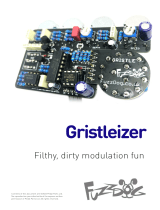Page is loading ...

Square Wave
Clone of the Univox
Square Wave Fuzz
PedalParts.co.uk

Schematic
BOM
R1 100K
R2 470K
R3 100K
R4 270K
R5 560K
R6 2M2
R7 560K
R8 10K
R9 27K
R10 2K2 (CLR)
D1,2 1N34A
Q1 2N5088*
Q2 2N5458**
C1 100n
C2 1n
C3 47u electrolytic
C4 33u electrolytic
C5 4u7 electrolytic
DIST 250KB
BAL 50KA
BIAS1 4K7 TRIM
BIAS2 10K TRIM
*other medium gain
transistors will work,
i.e. 2N3904
**other FETs can be used,
i.e. J201, 2N5457

The PCB is designed to have the pots mounted directly to it.
You can use wire if you like - simply connect the board pads to the
corresponding pins on the pots.
Pots and BIAS trimmers should be mounted on the back side of the PCB.
Wiring shown overleaf will disconnect the battery when you remove the
jack plug from the input, and also when a DC plug is inserted.
Snap the little metal tag off the pots to mount them flush in the box.
Be VERY careful when bending the legs of the 1N34A. The glass case is
very fragile and likely to break. Best to hold the leg with some needle-
nosed pliers against the case, and bend the leg with your finger so the
pliers are taking any strain away from the diode.
Diodes and transistors do NOT like heat. Be very careful when soldering them, and don’t leave
the iron on them for more than a couple of seconds. Using a heatsink (self-closing tweezers,
crocodile clip) on the leg you’re soldering will help avoid frying them. Same goes for the LED.
BIAS TRIMMERS
Before you mount BIAS1, adjust it so the resistance between pins 2 and 3 is around 1K. This
isn’t critical, but it will help in setting up.
Once you have the circuit all built and connected up for testing as shown on the next page, you
should adjust BIAS2 until you get between 1.6 - 1.8V at the Source of Q2. Measure this by
putting the negative lead of your multimeter on any ground point, the positive on any of the
points marked in red above.
With that set, adjust BIAS1 slowly until you get a satisfactory tone. Minor tweaking of BAIS2
may be necessary.
CLIPPING DIODES
The circuit will have a different feel if you miss out one or both of the clipping diodes. Try it
with none, then add only D1.
1 2 3

Test the board!
Very important. Under no circumstances will any troubleshooting
support be offered if you have skipped this stage.
Once you’ve finished the circuit it makes sense to test is before
starting on the switch and LED wiring. It’ll cut down
troubleshooting time in the long run. If the circuit works at this
stage, but it doesn’t once you wire up the switch - guess what?
You’ve probably made a mistake with the switch.
Solder some nice, long lengths of wire to the board connections for
9V, GND, IN and OUT. Connect IN and OUT to the jacks as shown.
Connect all the GNDs together (twist them up and add a small
amount of solder to tack it). Connect the battery + lead to the 9V
wire, same method. Plug in. Go!
If it works, crack on and do your switch wiring. If not... aw man.
At least you know the problem is with the circuit. Find out why, get
it working, THEN worry about the switch etc.
YRET
T
A
AT
B
NI UO TU

Wire it up
The Board GND connections don’t all have to directly attach to the
board. You can run a couple of wires from the DC connector, one to the
board, another to the IN jack, then daisy chain that over to the OUT jack.
It doesn’t matter how they all connect, as long as they do.
This circuit is standard, Negative GND. Your power supply should be Tip
Negative / Sleeve Positive. That’s the same as your standard pedals
(Boss etc), and you can safely daisy-chain your supply to this pedal.
Now... crank it!
PedalParts.co.uk
L
E
D
BOARD
OUT
BOARD
9V
BOARD
GND
BOARD
GND
BOARD
GND
BOARD
INPUT
BATTERY
+
IN
OUT
L
E
D
BOARD
GND
BOARD
LED+
+
/











